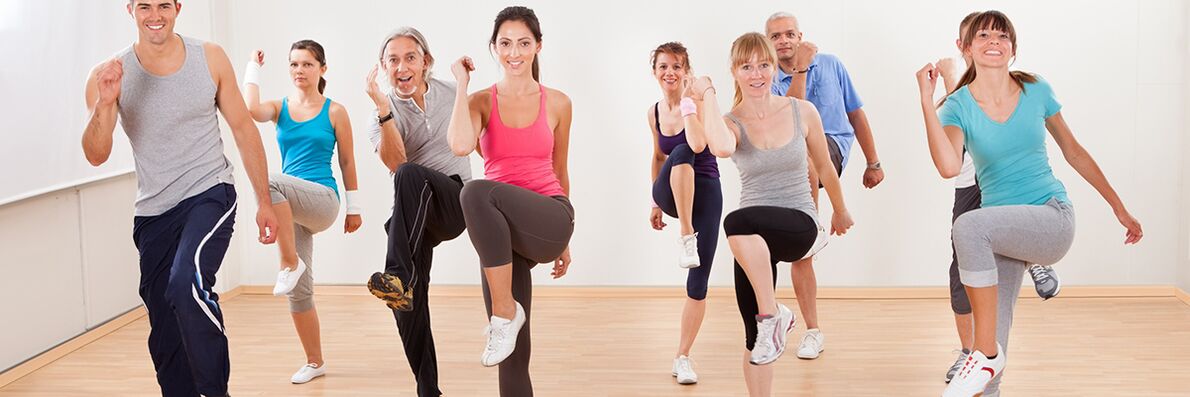
Did you notice that your legs are starting to numb quickly? And then they have to be kneaded for a long time and uncomfortably?
Does your foot swell and hurt for no apparent reason?
Maybe your skin on your feet is covered with an irritating network of blood vessels?
At least one yes - and he's in danger. There are probably varicose veins in the lower extremities. Because of this disease, the veins become enlarged, and this already leads to a violation of blood flow - some of the blood goes from the deep blood vessels to the superficial ones.
There are even disappointing statistics about this score. According to this, 30% of women and 10% of men in developed countries suffer from this disease. And these are just the ones who got to the doctors. It is conceivable that in reality these numbers are much higher, especially among those over 50 years of age.
Varicose veins begin with mild discomfort and do not cause serious problems. So cunning. Because of "such nonsense, " I don't want to go to the doctor, and the disease is progressing. The skin gradually darkens, the blood vessels swell like ropes, and even trophic ulcers appear. Blood clots appear in the affected veins, which later enter other organs and interfere with blood circulation in them. As a result, a fatal outcome is possible.
Have you ever considered dying from simple varicose veins?
People don't think about it. And it would be worth it.
After all, this is easy to avoid - you only need to consult a phlebologist in time. It creates a detailed complex treatment program, and exercise plays an important role in this.
Admit it, not all types of training are equally beneficial. Some exercises relieve venous pain, while others severely worsen your condition. Until emergency hospital treatment.
I agree, it is worth distinguishing one from the other.
In this article, we discuss in detail the effective treatment of varicose veins with gymnastics.
But wait, you can panic early. There may be no varicose veins at all. Compare your situation with the main signs of varicose veins.
How to recognize varicose veins, even if it is just beginning
Some of the signs are visible to the naked eye, others are only perceptible. Let's start with the external manifestation.
There are four people:
- A cobweb of blood vessels appears on the skin, most commonly red, blue, or purple.
- The veins are very swollen - they look like a rope stretched under the skin.
- Brown spots appear on the lower leg.
- The legs swell in the evenings.
The other group of symptoms is not visible from the outside, but causes discomfort:
- Cramps and burning sensation in the legs.
- Feeling of heaviness and pain.
- Itching near dilated vein.
- Severe pain after long standing or sitting.
As you can see, varicose veins manifest in different ways. But even if you don’t suffer from cramps and pain, that’s no reason to delay a doctor’s visit. The longer you wait, the more the disease progresses. One day medical care will not be an option but an urgent need.
Therefore, if you notice any signs of varicose veins in your legs, see a phlebologist immediately.
But what if you just don’t get to a doctor in the near future? And the consequences of varicose veins are frightening. Or the cramps, burning sensation, pain, and heaviness in your leg are so high that you already want to climb the wall. We will tell you how you can help yourself in a situation like this.
The discomfort caused by varicose veins will be reduced if you follow these 7 best practices
Let’s talk about the minus right away - these techniques don’t have an immediate effect. Although we really want it. But at least they gradually reduce the discomfort caused by varicose veins. Here are 7 tips:
- Exercise as often as possible. . . Any exercise is good for blood circulation. Except maybe heavy lifting and running. But let's get ahead of ourselves.
- Wear compression stockings. . . It supports the walls of blood vessels and relieves pressure on them. The swelling and tightness are relieved and the legs are relaxed.
- Do not sit or stand still for long periods of time - walk every hour.This puts extra strain on the veins in the legs and prevents the blood from stagnating. If you are standing at work, try to sit down for a few minutes regularly. With legs raised. If you sit for a long time, get up and walk for at least a few minutes every hour to have your feet pump blood back into your heart. The same is true for road trips - stop every 45-60 minutes for a short walk.
- Do not stand near an open flame or hot radiator.This impairs blood circulation.
- Eat less salty foods. . . The salt in the body interferes with the circulation of fluid.
- Take a relaxing bath at the beginning of the day, not at the end. . . And it's better to be completely without them.
- Do not sleep while sitting. . . In this situation, blood circulation is difficult. Place your feet horizontally to reduce stress on the dishes.
Remember, even strict adherence to our advice will not cure varicose veins. See a phlebologist - this is the only way to get rid of diseased blood vessels forever.
The doctor will tell you the next steps - sometimes with medication, sometimes with painless and quick surgery, but the treatment is always accompanied by lifestyle changes and exercise. We were just talking about lifestyle. And now we show you the most effective practices.
These exercises relieve the symptoms of varicose veins, slow it down and prevent complications.
The dilation of the blood vessels is largely caused by the stagnation of the blood. Therapeutic leg exercise for varicose veins and edema helps to lower blood pressure and maintain blood circulation. It also improves the tone of the venous walls - so the blood vessels do not dilate even as the pressure increases.
The choice of practice depends on the stage of the disease. But in any case, follow the motto: "it is better to walk and lie than to sit and stand. "
Walking, running, cycling and swimming are all beneficial. The easiest way to walk is to involve the calf muscles, improving blood circulation. Change position often and raise your leg.
If your legs have not yet become entangled with thick varicose veins and only the initial signs of the disease are visible, the following measures will be helpful:
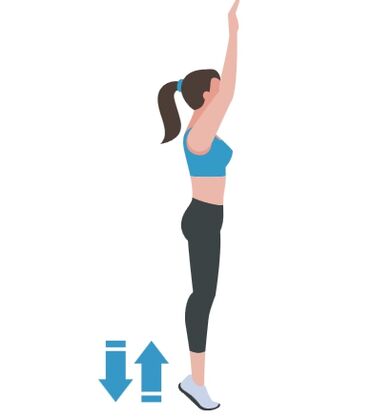 |
Stand on your toes, then slowly lower your heels until you touch the floor. Get up on your toes again and repeat the exercise. |
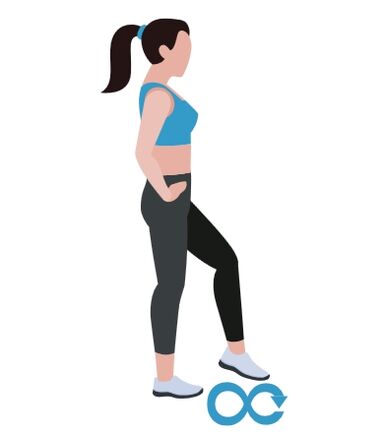 |
Raise your left leg and move it as if you were writing an eight. Repeat with your right foot. |
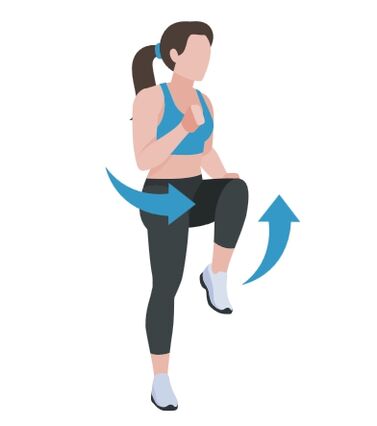 |
Get in place and swing vigorously with your arm. Raise your knees to the highest possible height - waist height. |
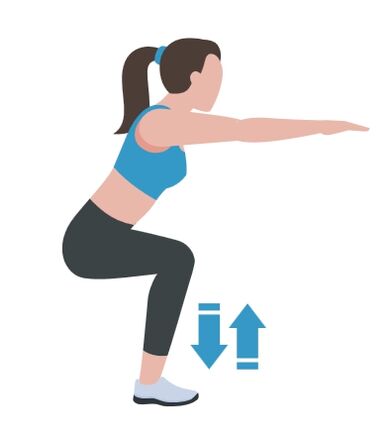 |
Stand up straight and stretch out your arms in front of you. Sit down slowly. Make sure your knees do not cross the border of your feet. |
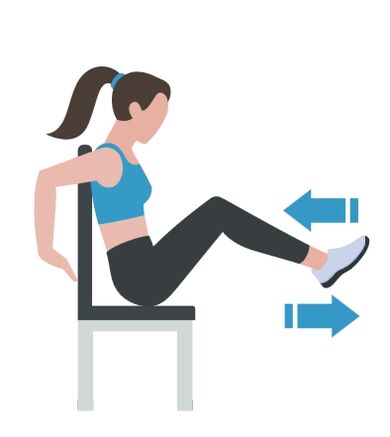 |
Sit down and put your hands behind the back of the chair. Raise your leg towards your torso and stretch it forward. |
In fact, your actions are aimed at improving blood circulation in your lower extremities.
Now let’s look at working with your feet - it’s a basic exercise and doesn’t require much effort and a lot of time.
Here's how to do it:
- Lie down or sit with your feet above your knees.
- Use your fingertips as a brush and draw a circle in the air. Do not move your whole leg, only your ankle.
- Pull the socks towards you to the limit. You will feel warmth in your calf muscles.
- Stretch your toes and lower your heels, moving your calf muscles.
- Turn your legs - first outwards and then towards each other.
- Repeat the exercise several times.
No special equipment is required for such activities. Take a seat on your favorite couch, lift your legs and exercise your joints. Remember to do varicose vein exercises regularly and you can easily improve your blood circulation.
We have an even more effective workout kit - it can stretch the muscles and joints not only of the legs but also of other parts of the body. However, it will take more time to find this. If this is not possible, stop with the previous exercises. If you can cut extra minutes, do the above and plus this complex.
Nevertheless, it stimulates blood circulation throughout the body, not just the legs.
Neck and head activities:
- We make circular movements with our heads - 10 in one direction, 10 in the other. Move slowly, feel the muscles of your neck work.
- The chin is pulled 3-4 times to the chest and then the back of the head is pulled back, the same 3-4 times. Slowly and carefully.
Exercises for shoulders and arms:
- We make circular movements with our shoulders forward and backward. We move our shoulders slowly, pulling the muscles.
- We straighten our arms and perform circular movements. They don’t have to be waved like a windmill. Hold for 2 turns. / minute speed. Don't hold your breath.
Exercises for the lower back:
- Place your hand on the belt. Turn the lower back completely to one side and then to the other side 10 times.
- Lean back and forth. Keep your feet in one place.
Foot activities:Do 10 squats slowly. No additional weight can be used.
Press classes:
- Lie on your back and move your legs like pedaling - practice cycling.
- Perform the twist while lying down.
We completely forgot to talk about sports. But this is what we are most often asked about. The most rewarding sport for you is swimming. When immersed in water, the pressure in the circulatory system returns to normal. Swimming has beneficial not only on the heart but also on the immune system and nervous system. It also strengthens the leg muscles.
What about another sport? Is it possible to run, for example?
Not all exercises are good for blood vessels. Let’s move on to those that could seriously harm you.
What exercises will kill the whole result of treating varicose veins
Suppose you are the ideal patient. Follow all your doctor's instructions: take medication, wear compression underwear, change your lifestyle. The symptoms of the disease gradually disappear. You're happy, the doctor is happy.
And then you think, why not solidify the result with regular training? And in order to completely forget about varicose veins and train your legs, you decide to squat under a good load.
Bad idea. Now all the work is down the drain. The blood vessels dilate even more than before.
What's up?
There are several practices that increase the load on the veins and destroy them as the vessel walls weaken:
- Strengthening exercises.
- Weighted squats.
- Prolonged use of the exercise bike.
- Jump high and long.
- Running on a hard surface.
No treatment will help if you continue to run or lift regularly in the gym. Therefore, do not tempt fate.
5 powerful accelerators for recovery from varicose veins
Yes, they are everyday. We've talked about some of them. But believe me, they are very important and worth repeating.
If you have already consulted a phlebologist and started arriving, these 5 tips will help you regain your health faster:
- Do not sit or stand in the same position for long periods of time. It is especially dangerous to cross your legs - this interferes with blood circulation.
- Do the recommended exercises regularly, walk more, and wear comfortable shoes.
- Use compression stockings selected by your doctor.
- Watch your weight. In obese people, the load on the venous system increases.
- After completing the exercises, lie on your back and rest your legs against the wall so that you are above your head. This allows blood to flow out of the legs.
But this is not a panacea. Again, these recommendations only help in combination with treatment. You will not be able to cope with the disease without the help of a doctor.
By the way, do you remember talking about the symptoms of varicose veins? Let's say you found them. But only a phlebologist can make an accurate diagnosis. Remember, treatment begins with the correct diagnosis.
Where to diagnose varicose veins
The accuracy of the diagnosis of varicose veins in the lower extremities depends on the equipment of the clinic. During the examination of patients, doctors perform ultrasound duplex angioscanning. A quick and painless method to examine superficial and deep blood vessels.
The doctor clearly sees the problem area of the veins and the obstacles to blood flow. Quickly identifies weakened venous keys.
The test allows the phlebologist to obtain accurate information about the blood vessels and make a detailed treatment plan.
But diagnostics is just the beginning. Every patient needs treatment first. It is important who will handle it and on what devices.












































